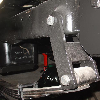J_C
Explorer Addict
- Joined
- July 30, 2009
- Messages
- 6,064
- Reaction score
- 2,195
- City, State
- Florence, KY
- Year, Model & Trim Level
- 1998 XLT 4WD 4.0L SOHC
It will stabilize the ride if you have a like-new rear leaves or the monroe coilover shocks, but not because of the lower ride height but rather more preload on the springs. The result is not better handling but rather a smoother ride over bumps. Having old leaves does the same thing. I'd forgotten what mine rode like when newer since it gradually changed but the moment I put the monroe coilovers on, i was instantly reminded.So, just wondering, if you carried 200 lbs of kitty litter sacks on the back seat floors, would it stabilize or lower the center of gravity enough?











